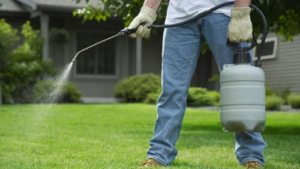Roofing is the top layer of the building envelope and protects against rain, snow, sunlight, extreme temperatures, and wind. The choice of materials affects not only cost and appearance but also future maintenance needs.
Before hiring a roofer, verify credentials and insurance. Ask for references and reviews, and obtain a contract that details the price, work schedule, and warranty information. Click the https://erieroofingpa.com/ to learn more.

Roofing has long been a critical element of building construction, protecting people and possessions from harsh weather conditions. Human ingenuity and constant search for progress led to better materials, designs and techniques. The roof has been a symbol of shelter since pre-historic hunters and gatherers retreated into caves for protection from rain and cold.
The earliest roofs were simple, raw affairs built with whatever local natural materials were at hand. Animal skins, mud and sticks were common ingredients in the making of these early structures. As populations grew and societies developed, however, more durable and fire-resistant materials were sought.
Thatching is among the oldest forms of roofing, using woven straw or reed to cover and protect dwellings. This was a practical approach that endured for centuries, but it was susceptible to fire and rot, making it unsuitable for permanent residences. By 735 AD, the next big leap came with clay tile roofing. This was developed and used by the ancient Greeks and Romans and then spread throughout Europe.
Wood became a popular roofing material in America as well, with European settlers favoring cedar wood shakes and shingles. This would continue into the 18th century, when residents began treating shingle surfaces with pine pitch and linseed oil to extend their life and protect against sun, rain and other elements that cause premature deterioration.
Rolling and seamed materials that could be shaped and assembled on-site made possible much larger industrial and residential buildings. As these innovations emerged, craftsmen and women began specializing in roofing. Individuals with the skills and talent to cut, shape and fire clay tiles or hand-split cedar shingles were in high demand. By the middle of the nineteenth century, when railroads reached most parts of the country, a wide variety of roofing was available to home builders.
Materials
There are many different materials used in roofing, from natural products like thatch and slate to man-made synthetics. Regardless of what type of roof you choose, it’s important to have a secondary water-resistant material installed as the underlayment. This is usually felt or a synthetic product that’s laid over the entire surface of the roof before the actual roofing materials are placed on top.
The most common roofing materials are asphalt shingles, wood shakes and clay tile. Each has unique benefits and characteristics. For instance, wood shingle roofs can last up to 60 years in relatively dry climates but are susceptible to damage from hail and wind. Clay tile, on the other hand, is more resilient against storms but can be very heavy and difficult to install.
Metal is another roofing option, and one of the most durable. It’s also very attractive and can add a touch of class to any home. Metal roofs are available in several styles including standing seam metal that locks into place, and corrugated galvanized iron or a coloured alloy of zinc and aluminium. These are best suited for low pitched roofs that can be built with a 0.5/12 to 3/12 slope.
Flat or membrane roofing is popular in commercial buildings, apartment complexes and even some residential applications. It’s important to work with an experienced roofing service company when selecting a flat roof treatment because this type of roofing is not as forgiving as other types and can be prone to leaks if improperly installed or damaged.
There are several types of flat roofing treatments, including single-membrane systems like EPDM, rubber and thermo-polyolefin (TPO), and built-up roofing that includes layers of tar and asphalt with an additional protective layer of gravel or mineral granules. The ballast method is also an option for flat roofs and uses heavy rocks arranged on top of the membrane to help hold it in place.
For a green or earthy roof, natural products like thatch and straw are an excellent choice. Thatch consists of woven plant stalks in overlapping rows, while straw uses either rye straw or a more substantial crop such as rice straw. Other types of roofing that use natural materials include coir, which uses coconut fibers; jute, which is often used for sheds and other small structures; and reed or acacia thatch, which is suitable for tropical roofs.
Shapes and Styles
Roofs are an integral part of any building, protecting the people and things inside from weather and other environmental factors. But roofs come in many shapes and styles, each offering unique benefits. Flat roofs, for example, are essentially completely flat with a small pitch to allow water to drain away from the building, which helps prevent moisture damage. Monitor roofs, which look like the letter “A,” are also fairly common and provide a lot of natural lighting without requiring windows. Other roofing shapes are less commonly used but still effective, including gable roofs and hipped roofs. All of these can be a great option for your home or business, depending on what you’re looking for in a roof and the climate where it’s located.
Installation
The roof of a building serves as its main shield against the elements, protecting people and property inside. It is also critical to the structural integrity of a building. Whether you need to replace an existing roof or are building a new structure, there are many different roofing options available. Each type offers its own unique benefits, ranging from longevity to fire resistance.
During the installation process, the crew will first set up protective measures around your home. Tarps are placed over shrubbery and landscaping, while garbage cans are covered to prevent any debris from falling into them. Then, they will begin to remove the old roof covering and install the new one.
Before hiring a contractor for your project, be sure to compare quotes carefully. Make sure that each includes the cost of materials, labor, permits and any additional charges. Additionally, ask potential contractors for references from past projects that are similar to yours. This will help you determine which has the experience and track record to meet your needs. Lastly, always hire licensed and insured professionals to work on your roof. This ensures that they follow proper safety protocols and are able to perform the job safely and effectively.








